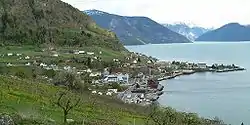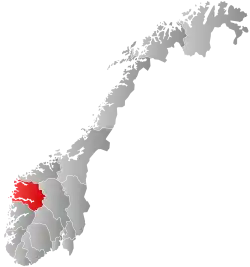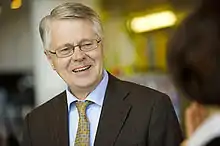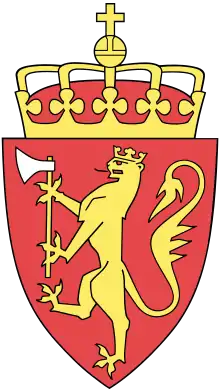Leikanger
Leikanger (Urban East Norwegian: [ˈlæ̂ɪkɑŋər] (![]() listen)) is a former municipality in Sogn og Fjordane county, Norway. It was located on the northern shore of the Sognefjorden in the traditional district of Sogn. The administrative center was the village of Hermansverk, which also was the administrative center of the old Sogn og Fjordane county.
listen)) is a former municipality in Sogn og Fjordane county, Norway. It was located on the northern shore of the Sognefjorden in the traditional district of Sogn. The administrative center was the village of Hermansverk, which also was the administrative center of the old Sogn og Fjordane county.
Leikanger kommune
Sander Strong Kato Linde | |
|---|---|
 View of Hermansverk | |
 Sogn og Fjordane within Norway | |
 Leikanger within Sogn og Fjordane | |
| Coordinates: 61°13′51″N 06°47′23″E | |
| Country | Norway |
| County | Sogn og Fjordane |
| District | Sogn |
| Established | 1 Jan 1838 |
| Disestablished | 1 Jan 2020 |
| Administrative centre | Hermansverk |
| Government | |
| • Mayor (2015-2019) | Jon Håkon Odd (Ap) |
| Area | |
| • Total | 180.10 km2 (69.54 sq mi) |
| • Land | 177.44 km2 (68.51 sq mi) |
| • Water | 2.66 km2 (1.03 sq mi) 1.5% |
| Area rank | 342 in Norway |
| *Area at municipal dissolution. | |
| Population (2019) | |
| • Total | 2,331 |
| • Rank | 302 in Norway |
| • Density | 13.1/km2 (34/sq mi) |
| • Change (10 years) | 8.1% |
| Demonym(s) | Systrending[1] |
| Time zone | UTC+01:00 (CET) |
| • Summer (DST) | UTC+02:00 (CEST) |
| ISO 3166 code | NO-1419 |
| Official language form | Nynorsk[2] |
| Created as | Formannskapsdistrikt in 1838 |
| Succeeded by | Sogndal in 2020 |
| Website | leikanger |
The Leikanger/Hermansverk urban area had 2,144 inhabitants (2019), about 90% of the municipal population.[3] This urban area is often called Systrond, which is why a person from Leikanger is often called Systrending.
The 180-square-kilometre (69 sq mi) municipality is the 342nd largest by area out of the 422 municipalities in Norway. Leikanger is the 302nd most populous municipality in Norway with a population of 2,331. The municipality's population density is 13.1 inhabitants per square kilometre (34/sq mi) and its population has increased by 8.1% over the last decade.[4][5]
General information



Leikanger was established as a municipality on 1 January 1838 (see formannskapsdistrikt law). The original municipality was large and it was identical to the old Leikanger parish (prestegjeld) with the six sub-parishes (sokn) of Leikanger, Fresvik, Rinde, Vangsnes, Tjugum, and Mundal. In 1849, the sub-parishes of Vangsnes, Tjugum, and Mundal were transferred into the newly created Balestrand parish (prestegjeld). The new parish was separated from Leikanger municipality in 1850 to form the new Balestrand Municipality. This split left Leikanger with 2,368 residents.[6]
During the 1960s, there were many municipal mergers across Norway due to the work of the Schei Committee. On 1 January 1964, the Hella-Eitorn area (population: 31) was transferred from Balestrand back to Leikanger. Also, the Tingstad area (population: 5) was transferred to neighboring Sogndal municipality. These changes left Leikanger with 2,680 residents. On 1 January 1992, the sub-parishes of Leikanger lying south of the Sognefjorden, including Feios and Fresvik (total population: 572) were transferred to the municipality of Vik. This move left Leikanger with only one sub-parish: Leikanger.[6][7]
On 1 January 2020, Leikanger was merged with the neighboring municipalities of Balestrand and Sogndal to form a much larger municipality called Sogndal.[8]
Name
The municipality (originally the parish) is named after the old farm Leikanger (Old Norse: Leikvangir), since the first Leikanger Church was built there. The first element is leikr which means "sports" or "athletics" and the last element is the plural form of vangr which means "meadow". Prior to 1889, the name was written Lekanger.[9]
Coat of arms
The coat of arms was granted on 5 September 1963. The arms are green with a yellow-colored apple tree branch with two apples and three leaves attached. The apple tree branch is a symbol for the many orchards in the municipality and thus for the local economy. The three leaves symbolised the three parishes that used to make up the municipality (before two of them were transferred to Vik in 1992).[10]
Churches
The Church of Norway had one parish (sokn) within the municipality of Leikanger. It was part of the Sogn prosti (deanery) in the Diocese of Bjørgvin.
| Parish (sokn) | Church name | Location of the church | Year built |
|---|---|---|---|
| Leikanger | Leikanger Church | Leikanger | 1166 |
Government
All municipalities in Norway, including Leikanger, are responsible for primary education (through 10th grade), outpatient health services, senior citizen services, unemployment and other social services, zoning, economic development, and municipal roads. The municipality is governed by a municipal council of elected representatives, which in turn elect a mayor.[11] The municipality falls under the Sogn og Fjordane District Court and the Gulating Court of Appeal.
Municipal council
The municipal council (Kommunestyre) of Leikanger was made up of 17 representatives that were elected to four year terms. The party breakdown of the final municipal council was as follows:
| Party Name (in Nynorsk) | Number of representatives | |
|---|---|---|
| Labour Party (Arbeidarpartiet) | 7 | |
| Conservative Party (Høgre) | 1 | |
| Centre Party (Senterpartiet) | 5 | |
| Socialist Left Party (Sosialistisk Venstreparti) | 1 | |
| Liberal Party (Venstre) | 3 | |
| Total number of members: | 17 | |
| Party Name (in Nynorsk) | Number of representatives | |
|---|---|---|
| Labour Party (Arbeidarpartiet) | 7 | |
| Conservative Party (Høgre) | 2 | |
| Centre Party (Senterpartiet) | 3 | |
| Socialist Left Party (Sosialistisk Venstreparti) | 2 | |
| Liberal Party (Venstre) | 3 | |
| Total number of members: | 17 | |
| Party Name (in Nynorsk) | Number of representatives | |
|---|---|---|
| Labour Party (Arbeidarpartiet) | 7 | |
| Conservative Party (Høgre) | 2 | |
| Centre Party (Senterpartiet) | 3 | |
| Socialist Left Party (Sosialistisk Venstreparti) | 2 | |
| Liberal Party (Venstre) | 3 | |
| Total number of members: | 17 | |
| Party Name (in Nynorsk) | Number of representatives | |
|---|---|---|
| Labour Party (Arbeidarpartiet) | 7 | |
| Conservative Party (Høgre) | 2 | |
| Christian Democratic Party (Kristeleg Folkeparti) | 1 | |
| Centre Party (Senterpartiet) | 3 | |
| Socialist Left Party (Sosialistisk Venstreparti) | 2 | |
| Liberal Party (Venstre) | 2 | |
| Total number of members: | 17 | |
| Party Name (in Nynorsk) | Number of representatives | |
|---|---|---|
| Labour Party (Arbeidarpartiet) | 7 | |
| Conservative Party (Høgre) | 3 | |
| Christian Democratic Party (Kristeleg Folkeparti) | 1 | |
| Centre Party (Senterpartiet) | 1 | |
| Socialist Left Party (Sosialistisk Venstreparti) | 2 | |
| Liberal Party (Venstre) | 3 | |
| Total number of members: | 17 | |
| Party Name (in Nynorsk) | Number of representatives | |
|---|---|---|
| Labour Party (Arbeidarpartiet) | 7 | |
| Conservative Party (Høgre) | 2 | |
| Christian Democratic Party (Kristeleg Folkeparti) | 1 | |
| Centre Party (Senterpartiet) | 3 | |
| Socialist Left Party (Sosialistisk Venstreparti) | 1 | |
| Liberal Party (Venstre) | 3 | |
| Total number of members: | 17 | |
| Party Name (in Nynorsk) | Number of representatives | |
|---|---|---|
| Labour Party (Arbeidarpartiet) | 9 | |
| Conservative Party (Høgre) | 3 | |
| Christian Democratic Party (Kristeleg Folkeparti) | 2 | |
| Centre Party (Senterpartiet) | 3 | |
| Socialist Left Party (Sosialistisk Venstreparti) | 2 | |
| Liberal Party (Venstre) | 2 | |
| Total number of members: | 21 | |
| Party Name (in Nynorsk) | Number of representatives | |
|---|---|---|
| Labour Party (Arbeidarpartiet) | 9 | |
| Conservative Party (Høgre) | 4 | |
| Christian Democratic Party (Kristeleg Folkeparti) | 2 | |
| Centre Party (Senterpartiet) | 3 | |
| Socialist Left Party (Sosialistisk Venstreparti) | 1 | |
| Liberal Party (Venstre) | 2 | |
| Total number of members: | 21 | |
| Party Name (in Nynorsk) | Number of representatives | |
|---|---|---|
| Labour Party (Arbeidarpartiet) | 9 | |
| Conservative Party (Høgre) | 4 | |
| Christian Democratic Party (Kristeleg Folkeparti) | 2 | |
| Centre Party (Senterpartiet) | 2 | |
| Socialist Left Party (Sosialistisk Venstreparti) | 1 | |
| Liberal Party (Venstre) | 2 | |
| Cross-party common list (Tverrpolitisk Samlingsliste) | 1 | |
| Total number of members: | 21 | |
| Party Name (in Nynorsk) | Number of representatives | |
|---|---|---|
| Labour Party (Arbeidarpartiet) | 8 | |
| Conservative Party (Høgre) | 4 | |
| Christian Democratic Party (Kristeleg Folkeparti) | 2 | |
| Liberal People's Party (Liberale Folkepartiet) | 1 | |
| Centre Party (Senterpartiet) | 3 | |
| Liberal Party (Venstre) | 2 | |
| Cross-party common list (Tverrpolitisk Samlingsliste) | 1 | |
| Total number of members: | 21 | |
| Party Name (in Nynorsk) | Number of representatives | |
|---|---|---|
| Labour Party (Arbeidarpartiet) | 8 | |
| Conservative Party (Høgre) | 3 | |
| Christian Democratic Party (Kristeleg Folkeparti) | 3 | |
| New People's Party (Nye Folkepartiet) | 1 | |
| Centre Party (Senterpartiet) | 3 | |
| Socialist Left Party (Sosialistisk Venstreparti) | 1 | |
| Liberal Party (Venstre) | 2 | |
| Total number of members: | 21 | |
| Party Name (in Nynorsk) | Number of representatives | |
|---|---|---|
| Labour Party (Arbeidarpartiet) | 9 | |
| Conservative Party (Høgre) | 2 | |
| Christian Democratic Party (Kristeleg Folkeparti) | 3 | |
| Centre Party (Senterpartiet) | 4 | |
| Liberal Party (Venstre) | 3 | |
| Total number of members: | 21 | |
| Party Name (in Nynorsk) | Number of representatives | |
|---|---|---|
| Labour Party (Arbeidarpartiet) | 8 | |
| Conservative Party (Høgre) | 2 | |
| Christian Democratic Party (Kristeleg Folkeparti) | 2 | |
| Centre Party (Senterpartiet) | 4 | |
| Liberal Party (Venstre) | 5 | |
| Total number of members: | 21 | |
| Party Name (in Nynorsk) | Number of representatives | |
|---|---|---|
| Labour Party (Arbeidarpartiet) | 8 | |
| Conservative Party (Høgre) | 2 | |
| Christian Democratic Party (Kristeleg Folkeparti) | 1 | |
| Centre Party (Senterpartiet) | 3 | |
| Socialist People's Party (Sosialistisk Folkeparti) | 1 | |
| Liberal Party (Venstre) | 6 | |
| Total number of members: | 21 | |
| Party Name (in Nynorsk) | Number of representatives | |
|---|---|---|
| Labour Party (Arbeidarpartiet) | 9 | |
| Conservative Party (Høgre) | 1 | |
| Christian Democratic Party (Kristeleg Folkeparti) | 1 | |
| Centre Party (Senterpartiet) | 3 | |
| Liberal Party (Venstre) | 7 | |
| Total number of members: | 21 | |
| Party Name (in Nynorsk) | Number of representatives | |
|---|---|---|
| Labour Party (Arbeidarpartiet) | 9 | |
| Farmers' Party (Bondepartiet) | 2 | |
| Liberal Party (Venstre) | 7 | |
| Joint List(s) of Non-Socialist Parties (Borgarlege Felleslister) | 3 | |
| Total number of members: | 21 | |
| Party Name (in Nynorsk) | Number of representatives | |
|---|---|---|
| Labour Party (Arbeidarpartiet) | 13 | |
| Farmers' Party (Bondepartiet) | 4 | |
| Liberal Party (Venstre) | 10 | |
| Joint List(s) of Non-Socialist Parties (Borgarlege Felleslister) | 5 | |
| Total number of members: | 32 | |
| Party Name (in Nynorsk) | Number of representatives | |
|---|---|---|
| Labour Party (Arbeidarpartiet) | 15 | |
| Liberal Party (Venstre) | 4 | |
| Joint List(s) of Non-Socialist Parties (Borgarlege Felleslister) | 13 | |
| Total number of members: | 32 | |
| Party Name (in Nynorsk) | Number of representatives | |
|---|---|---|
| Labour Party (Arbeidarpartiet) | 8 | |
| List of workers, fishermen, and small farmholders (Arbeidarar, fiskarar, småbrukarar liste) | 8 | |
| Joint List(s) of Non-Socialist Parties (Borgarlege Felleslister) | 16 | |
| Total number of members: | 32 | |
| Party Name (in Nynorsk) | Number of representatives | |
|---|---|---|
| Labour Party (Arbeidarpartiet) | 11 | |
| Farmers' Party (Bondepartiet) | 2 | |
| Liberal Party (Venstre) | 5 | |
| Joint List(s) of Non-Socialist Parties (Borgarlege Felleslister) | 11 | |
| Local List(s) (Lokale lister) | 3 | |
| Total number of members: | 32 | |
Mayor
The mayor (ordførar) of a municipality in Norway is a representative of the municipal council who is elected either by the majority of the council. Jon Håkon Odd of the Labour Party was elected mayor for the 2015–2019 term.
Geography
Leikanger is located on the north side of the Sognefjorden and to the east of the Fjærlandsfjorden. It is bordered on the north and east by the municipality of Sogndal, on the west by Balestrand, and on the south (across the Sognefjorden) by Vik.
Buildings and structures
East of Leikanger, there are the Sognefjord Spans, three powerline spans with length over 4 kilometres (2.5 mi), which are currently the 2nd, 3rd, and 4th longest spans in the world. In 1955, the first Sognefjord Span was built near Leikanger. It was the longest span in the world from 1955 until 1997.
Sister cities/Twin towns
Leikanger has sister city agreements with the following places:
Notable people

- Iver Erikssøn Leganger (1629 in Leikanger – 1702) a priest, author and farm owner
- Georg Burchard Jersin (1767 in Leikanger – 1827) a Lutheran minister, rep. on the Norwegian Constitutional Assembly
- Olaf Huseby (1856 in Leikanger – 1942) a Norwegian-American bookseller and publisher
- Jakob Sverdrup (1881 in Leikanger – 1938) a Norwegian philologist and lexicographer
- Kjell Bondevik (1901 in Leikanger – 1983) a Norwegian politician, also wrote history books
- Oddvar Flæte (born 1944 in Leikanger) a politician, County Governor of Sogn og Fjordane 1994-2011
- Silje Nes (born 1980 in Leikanger) a Norwegian multi-instrumentalist, singer and sound artist
- Elise Thorsnes (born 1988 in Leikanger) a Norwegian footballer, played 125 games with the Norway women's national football team
References
- "Navn på steder og personer: Innbyggjarnamn" (in Norwegian). Språkrådet.
- "Forskrift om målvedtak i kommunar og fylkeskommunar" (in Norwegian). Lovdata.no.
- Statistisk sentralbyrå (1 January 2016). "Urban settlements. Population and area, by municipality".
- Statistisk sentralbyrå (2018). "Table: 06913: Population 1 January and population changes during the calendar year (M)" (in Norwegian). Retrieved 2019-12-08.
- Statistisk sentralbyrå. "09280: Area of land and fresh water (km²) (M)" (in Norwegian). Retrieved 2019-12-08.
- Jukvam, Dag (1999). "Historisk oversikt over endringer i kommune- og fylkesinndelingen" (PDF) (in Norwegian). Statistics Norway.
- Natvik, Oddvar (9 February 2005). "Some historical data on the 26 Kommunes". Archived from the original on 13 June 2008. Retrieved 23 June 2008.
- "Nye Sogndal kommune" (in Norwegian). Retrieved 2017-10-22.
- Rygh, Oluf (1919). Norske gaardnavne: Nordre Bergenhus amt (in Norwegian) (12 ed.). Kristiania, Norge: W. C. Fabritius & sønners bogtrikkeri. p. 124.
- "Civic heraldry of Norway - Norske Kommunevåpen". Heraldry of the World. Retrieved 2017-10-22.
- Hansen, Tore, ed. (2016-05-12). "kommunestyre". Store norske leksikon (in Norwegian). Kunnskapsforlaget. Retrieved 2019-04-06.
- "Table: 04813: Members of the local councils, by party/electoral list at the Municipal Council election (M)" (in Norwegian). Statistics Norway.
- "Tall for Norge: Kommunestyrevalg 2011 - Sogn og Fjordane". Valg Direktoratet. Retrieved 2019-10-29.
- "Kommunestyrevalget 1995" (PDF) (in Norwegian). Oslo-Kongsvinger: Statistisk sentralbyrå. 1996. Retrieved 2020-02-16.
- "Kommunestyrevalget 1991" (PDF) (in Norwegian). Oslo-Kongsvinger: Statistisk sentralbyrå. 1993. Retrieved 2020-02-16.
- "Kommunestyrevalget 1987" (PDF) (in Norwegian). Oslo-Kongsvinger: Statistisk sentralbyrå. 1988. Retrieved 2020-02-16.
- "Kommunestyrevalget 1983" (PDF) (in Norwegian). Oslo-Kongsvinger: Statistisk sentralbyrå. 1984. Retrieved 2020-05-14.
- "Kommunestyrevalget 1979" (PDF) (in Norwegian). Oslo: Statistisk sentralbyrå. 1979. Retrieved 2020-05-14.
- "Kommunevalgene 1975" (PDF) (in Norwegian). Oslo: Statistisk sentralbyrå. 1977. Retrieved 2020-05-14.
- "Kommunevalgene 1972" (PDF) (in Norwegian). Oslo: Statistisk sentralbyrå. 1973. Retrieved 2020-05-14.
- "Kommunevalgene 1967" (PDF) (in Norwegian). Oslo: Statistisk sentralbyrå. 1967. Retrieved 2020-05-14.
- "Kommunevalgene 1963" (PDF) (in Norwegian). Oslo: Statistisk sentralbyrå. 1964. Retrieved 2020-05-14.
- "Kommunevalgene og Ordførervalgene 1959" (PDF) (in Norwegian). Oslo: Statistisk sentralbyrå. 1960. Retrieved 2020-05-14.
- "Kommunevalgene og Ordførervalgene 1955" (PDF) (in Norwegian). Oslo: Statistisk sentralbyrå. 1957. Retrieved 2020-05-14.
- "Kommunevalgene og Ordførervalgene 1951" (PDF) (in Norwegian). Oslo: Statistisk sentralbyrå. 1952. Retrieved 2020-05-14.
- "Kommunevalgene og Ordførervalgene 1947" (PDF) (in Norwegian). Oslo: Statistisk sentralbyrå. 1948. Retrieved 2020-05-14.
- "Kommunevalgene og Ordførervalgene 1945" (PDF) (in Norwegian). Oslo: Statistisk sentralbyrå. 1947. Retrieved 2020-05-14.
- "Kommunevalgene og Ordførervalgene 1937" (PDF) (in Norwegian). Oslo: Statistisk sentralbyrå. 1938. Retrieved 2020-05-14.
External links
| Wikimedia Commons has media related to Leikanger. |
- Municipal fact sheet from Statistics Norway (in Norwegian)
- Official Leikanger municipality website (in Norwegian)
- NRK: Leikanger (in Norwegian)




